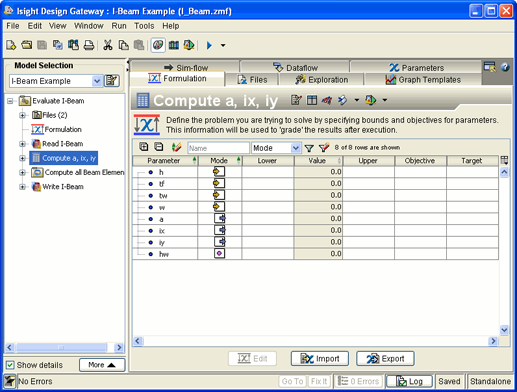How Isight Generates Problem Formulations | ||
| ||
If you then make additional changes to the internal problem formulation (parameters) using the component editors, Isight automatically syncs the general problem formulation with the internal problem formulation. Alternatively, if you define the problem formulation on the Formulation tab before defining the parameter attributes using the component editors, the parameters will inherit the general problem formulation. For more information, see About Design Parameters Initialization.
For example, if you add a DOE component to your model, you can define the problem formulation first using the Formulation tab. If you then select factors and responses in the DOE component editor, the general problem formulation will be inherited. Similarly, if you configure the factors and responses first in the DOE Component Editor, the general problem formulation will be extracted from the internal DOE configuration.
If you configure a problem formulation in a process component (parent component) that has a child component with the same parameters defined, the child component inherits the problem formulation for those defined parameters. You can override the inherited problem formulation by defining a new problem formulation at that component level.
If you change a component from one component to another, the problem formulation is inherited from the previous component. For example, if you defined a problem formulation in the Optimization component and change the Optimization component to a Monte Carlo component, the Monte Carlo component inherits the problem formulation from the Optimization component. For information about changing a component, see Changing Components in a Simulation Process Flow.
All process components of a task plan inherit the problem formulation of the original analysis simulation flow. For more information about task plans, see About Task Plans.
The Runtime Gateway uses the formulation to visually indicate how the runs of any component measure up against the stated objectives/constraints. You can change a problem formulation in the Runtime Gateway so that the effect on grading runs can be seen (see Understanding Run Grading). If you do so and then re-execute the model, Isight uses the new problem formulation for that execution.
The following figure shows an example of the Formulation tab in the Design Gateway that you can use to define the general problem formulation:

The Formulation tab lists all the selected component’s parameters and any parameters from the subflow that are not mapped to the selected component.